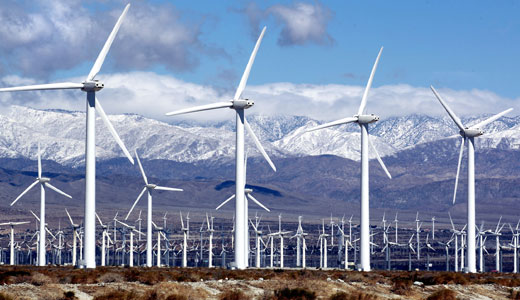
WASHINGTON – Just how old and how badly in need of upgrading is the U.S. power grid? Mike Langford says Thomas Alva Edison can answer that for you.
When Edison invented the light bulb, says Langford, the Utility Workers president, he also had to arrange how to power it. In other words, Edison had to contract for the power grid, that mix of transformers, plants, retransmission stations and lines that brings electricity into your homes – and everywhere else.
Edison wouldn’t recognize today’s light bulbs, compared to those he used to light the streets of Manhattan after he invented incandescent bulbs in 1879, Langford says.
“But if you brought back Thomas Edison today and put him in our transmission system, he’d be right at home. Because it hasn’t changed a bit,” Langford, whose union’s members repair and replace pieces of that grid, comments wryly.
And that’s a big problem and a big opportunity for good, green jobs, he told a conference on that cause on April 17.
Infrastructure repair and replacement was a key issue for many unionists at the D.C. meeting April 16-18, which drew 1,500 participants from labor and environmental organizations, including union leaders. Langford and American Federation of Teachers President Randi Weingarten particularly concentrated on infrastructure repair.
Langford, in a panel session, emphasized the age of U.S. infrastructure – the grid included – and the fact that much of it is inefficient, wearing out, or both.
“The Chinese have a million-volt transmission line that runs over 1,200 miles,” he added. Their power loss over that distance is small, he said. “Our maximum power line over that distance is 760,000 volts. Guess what our power loss would be?” he challenged the crowd. “80 percent.”
Weingarten, in that same session, added that repairing and retrofitting schools to make them energy efficient benefits workers now, kids now and the nation in the future.
After all, she pointed out, if a 70-year-old school has an overloaded electrical system, it can’t handle computers for the students. If its windows leak and it’s drafty, the students are cold, uncomfortable, get sick more frequently, miss more school days and can’t learn. And if they can’t learn, they can’t become future productive workers and contributors to society, she contended.
Langford and Weingarten said schools and power lines aren’t the only outdated parts of U.S. infrastructure that are ripe for repair in a “green” way. Both cited a recent report grading various aspects of infrastructure, issued by a top engineering society. Marks ranged from “C-” on downwards to “F.” The average was around a “D.”
That’s the opportunity the U.S. should grasp, the two contended: Repair and replace infrastructure, putting thousands of Utility Workers and building trades members to work, while “greening” buildings and making transmission lines efficient.
But they agreed politics stands in the way. In Ohio, for example, electric utilities “are not only trying to reverse standards for (using) renewable energy” from sources such as solar, wind and water power, “but electrical efficiency standards, too,” Langford said. Politicians, most of them Republicans, are aiding and abetting that reversal.
Weingarten said AFT is so fed up with state and federal government inaction on infrastructure that it’s taken matters into its own hands – as have the Fire Fighters, the Service Employees, AFSCME, the National Education Association and the AFL-CIO.
Together, they pledged to invest $10 billion of union pension funds’ money in renewing and rebuilding infrastructure, from retrofitting schools to repaving roads.
“Some people looked at us as if we were crazy,” when the unions unveiled their plan several years ago, Weingarten said. “But it’s all being built with union labor, and we’re halfway to that (investment dollar) goal.”
The infrastructure investment will particularly show up in her home state of New York, still reeling from the billions of dollars in damage super-storm Hurricane Sandy caused. Her home union, the United Federation of Teachers, had its pension fund arrange the lead investments there. “It’s a win-win-win,” Weingarten exclaimed, as the investments give high returns, provide union jobs and improve infrastructure.
Still, the two warned, the private sector can’t shoulder the infrastructure load all by itself. Langford noted government has to step in to force utilities to upgrade the grid, rather than let their execs and shareholders pocket the profits while ignoring their ratepayers. “We’re paying for service and not getting it,” he said.
And Weingarten said a national infrastructure bank, which would provide federal seed money and loans to be matched and leveraged by the private sector, is needed to choose and fund nationally significant projects. That cause, too, is one that unions – and conference delegates – have pushed for years. But the infrastructure bank has died in the GOP-run House.
Photo: A wind farm near Palm Springs, California. Brian van der Brug/AP & Los Angeles Times

MOST POPULAR TODAY

High Court essentially bans demonstrations, freedom of assembly in Deep South

Zionist organizations leading campaign to stop ceasefire resolutions in D.C. area

UN warns that Israel is still blocking humanitarian aid to Gaza

U.S. imperialism’s ‘ironclad’ support for Israel increases fascist danger at home







Comments